Standings

Team Record by Game Type
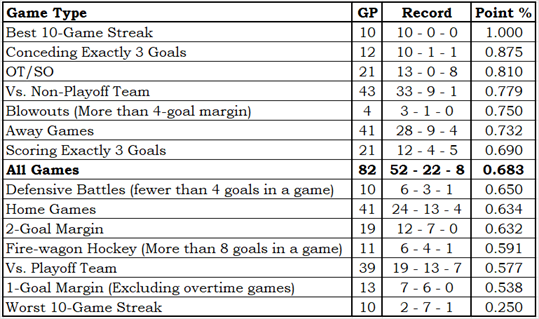
More information regarding Team Record by Game Type
The Team Record by Game Type is based on an idea I saw in a Bill James Baseball Abstract (exact year unknown; it was in an Abstract from the 1980s). It showed how a specific team did in various types of games, and it is exactly the sort of thing that I really like.
The table is sorted by point percentage (Point % column), so each team’s content order will be different and logically related game types could be well separated. Since that is the way that Bill James did it, it must be the correct way.
OT/SO is a team’s record in overtime and shootout games. These games are impossible to lose, so the loss count will always be zero. A loss is a game in which a team gets no standing points; a tie is a game in which a team gets one standing point, as they do in overtime or shootout losses.
Conceding Exactly 3 Goals and Scoring Exactly 3 Goals show how teams did in games where they scored enough to have a chance to win or conceded just enough that they could win.
1-Goal Margin, 2-Goal Margin and Blowouts (More than 4-goal margin) are for games with scores like 6-5, 6-4 and 6-1 (respectively). The 1-goal games do not include OT/SO games.
Defensive Battles and Fire-wagon Hockey are for games with scores like 2-0 and 7-3 (respectively). The entire set of Defensive Battle scores are 3-0, 2-1, 2-0 and 1-0.
Vs. Playoff Team and Vs. Non-Playoff Team are based on opponent playoff status at the end of the season, not at the time of the game. Two examples: Pittsburgh would be a non-playoff opponent and Florida would be a playoff opponent.
Best 10-Game Streak and Worst 10-Game Streak need no further explanation.
Home Games, Away Games and All Games need no further explanation.
Hide additional Information regarding Team Record by Game Type
Talent Distribution

More information regarding Talent Distribution
The Talent Distribution tables show how player talent is distributed in a team.
The Count by Category table shows how many players the team has in each of the six PR Categories, broken down by position. It is good to have PR-Elite and PR-Star players.
The PR% by Age Group table shows where the team’s productivity lies by age group. For context, it also shows the league averages.
If a team has a lot of talent in the younger age groups you would think that was a good omen for the team’s future, while if the team has a lot of talent in the older age groups that would seem to be a bad omen: old players don’t get better, they get worse.
The PR% by Draft Status shows how a team acquired the talent they have, by one of three categories: they drafted the player, another team drafted the player, or the player was undrafted. In order to provide a little context, league averages are also shown.
This information is more “how a team got their talent” than “how a team should get its talent.”
It would be nice if the players a team drafts do well and stay with the team, but it is also nice to acquire talent from other teams, and it is also nice to sign an undrafted free agent.
Hide additional Information regarding Talent Distribution
Return From Play Dollars
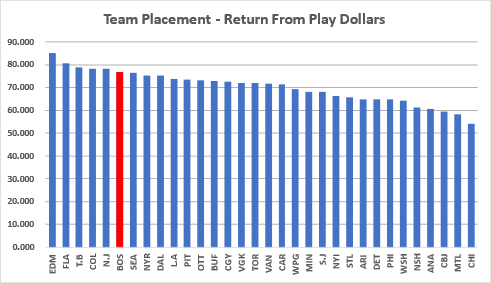
More information regarding Return From Play Dollars
Return From Play (RFP) translates a player’s Productivity Rating into a dollar amount that is loosely based on the 2021-22 salary cap. It has nothing to do with how much a player was paid: it is about how much a player was worth.
We do this sort of thing all the time. “They charged me $10 for the hamburger, but it tasted like a $30 steak.” “I bought my used car for $10,000, but it rides like a $50,000 car.” “I paid $500 a night for a hotel in Toronto; the place might have been worth $200.”
In 2022-23, Zach Hyman (EDM) was in the PR-Star category and had a PR-Score of 8.6554. His RFP was $7,040,000, based on his PR-Score. Essentially, he played like a $7-million player.
Seasonal RFPs can be added together, producing a total RFP for a player over time. Auston Matthew’s (TOR) return from play in his career is $55,920,000.
The RFP of all players on a team can be added together, telling us something about the level of talent on it. Colorado’s RFP in 2022-23 was $78,340,000, while the RFP of Columbus was $59,455,000. Colorado had the better players.
Hide additional Information regarding Return From Play Dollars
Lines and Pairs
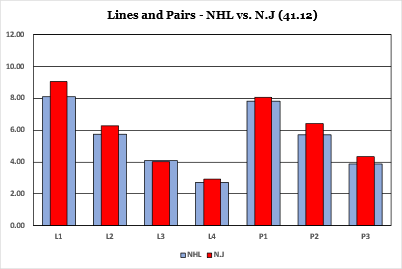
More information regarding Lines & Pairs
The Lines and Pairs section consists of the chart above and the table below. The chart shows where the team’s talents are in comparison to the league average, while the table shows which players are on which forward line or which defensive pair.
Players are sorted by team, by position and by their PR-Score. Traded players will use have their PR-Score apportioned based on how many games they played with each team. A player who played 50 games with one team and 25 games with a second team will be assigned 2/3 of his PR-Score for the team he played 50 games for, and 1/3 of his PR-Score for the team he played 25 games for.
The top three forwards are identified as the first line, the next three as the second line, and so on. There is no guarantee that any line has actually played even one second together during the season: the lines and pairs are solely based on productivity rating.
There are times when a player who was traded at the trade deadline will appear on the L&P table for both teams he played for. That just means that he was one of the top twelve forwards (or top six defensemen) for both teams, based on the statistics he accumulated with each team.
Hide Information regarding Lines & Pairs

Team Leaders – Stapled To The Bench Categories

More information regarding Team Leaders – Stapled To The Bench Categories
The Team Leader table identifies the best player on the team in six Stapled To The Bench categories. I will not go into the formulas used.
- The Most Productive player is the player with the highest PR-Score.
- The Most Valuable player is the player with the highest VR-Score.
- The Best Center is the player who was their team’s most highly rated center.
- The Most Disruptive player is based on blocked shots, hits and take-aways.
- The Best Power Player is based on both individual and team statistics that comes from powerplay time-on-ice.
- The Best Penalty Killer is based on statistics that comes from short-handed time-on-ice.
Hide additional Information regarding Team Leaders – Stapled To The Bench Categories
Team Leaders – On-Ice Situations
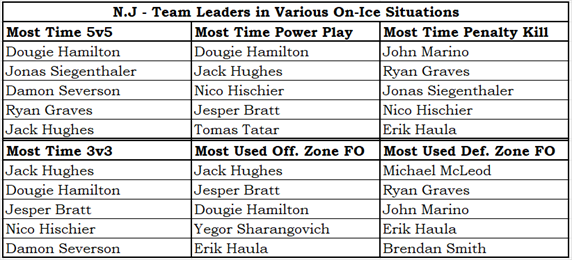
More information regarding Team Leaders – On-Ice Situations
- The Team Leaders for various On-Ice situations table shows the players who got the most ice-time in certain situations.
- In the time categories, players are ranked by ice-time (in minutes played) over the season, not on ice-time per game played.
- A player who is normally heavily used in a certain situation but who missed a non-trivial number of games could fall out of the top five for his team.
- The two non-time categories show players ranked by the percent of their shifts that started in offensive or defensive zones.
- While I normally prefer to use actual counts, it seemed correct for these two categories to use percentages, provided they played a minimum number of minutes during the season.
- A minimum-time criteria avoids avoid identifying a player who played one or two games during the season as being one of the most heavily used offensive zone or defensive zone players.
Hide Information regarding Team Leaders – On-Ice Situations
Team Essay – Big Ups
The Devils made a huge step forward from the previous season, improving by 49 points in the standings. They increased scoring by 44 goals and decreased goals against by 80. Those are large and very large improvements, and the impact was obvious: an increase of 49 standing points. In non-technical terms, that is a massive improvement.
On the defensive side of things, the decrease in goals against is almost completely attributable to a massive improvement in the play of their goalies. A team-level defensive improvement can be seen in the three-shot drop in shots against per game from the season before. In nets, their goalie play was “slightly above average” in 2022-23, while it was “woefully below average” in 2021-22.
The following table shows typical goalie data for the previous two seasons. 2021-22 data is in red, 2022-23 data is in black. In both sets of data, goalies are sorted by time-on-ice. The last two rows are season totals.
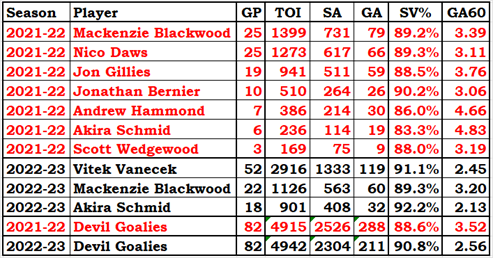
In 2022-23, Devil Goalies faced 3 fewer shots per game (team-level improvement) and saved 2% more of the shots they faced (possibly team-influenced improvement). Their goals against average, the final column (GA60), shows the improved of 0.96 goals per game.
I prefer non-traditional statistics for evaluating goalies.
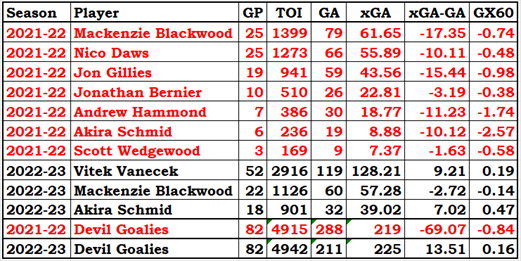
The non-traditional statistics are expected goals against (xGA), expected goals against minus goals against (xGA-GA), and what I call Goalie Index (GX60), which is how many goals against a goalie saves per 60 minutes of play, compared to an average goalie.
Earlier, I said the Devils defensive improvement was ‘almost completely attributable to a massive improvement in the play of their goalies.’ On looking at the data in the table above, it is possible that the word ‘almost’ should be removed. The team in front of the Devil goalies reduced shots against by more than 200, but the expected goals from all shots increased a little (225-219=6). It’s gotta be the goalies who take the credit.
As to the forwards and defensemen, several players were much more productive this season. Nico Hischier went from a PR-First5 rating to PR-Star, while both Dougie Hamilton and Jack Hughes improved from PR-Regular to PR-Star.
Timo Meier seemed like a nice mid-season acquisition, but the Devils as a team had better results before his arrival than after. To me, the results don’t reflect the play: the Devils played better as a team with Meier, they just didn’t get the results they should have.

In terms of goals scored and allowed, the Devils were a little worse in both categories after acquiring Timo, by a total of 0.27 goals per game. In terms of their play, they were a little better with Timo, by a total of 0.40 goals per game. That is a great example of small-sample (only 21 games) puck luck for you.
You don’t improve by 49 points in the standings without getting better results offensively and defensively. New Jersey went from the 19th best offensive team and the 29th best defensive team to 4th best and 8th best.
Their defensive improvement was massive, it was brought about by the goalies, but it wasn’t caused by stellar goalie play. The goalies played well, but it was a huge improvement because the season before they had played terribly.
Their offensive improvement was solid, and it was largely a team-level improvement. In both 2021-22 and 2022-23, the Devils scored about as many goals as expected, based on the number and quality of their shots. No one player was responsible for the improvement in their offensive expectations.
The Devils have a good amount of young talent. They’ll be an interesting team to watch in the coming seasons.
